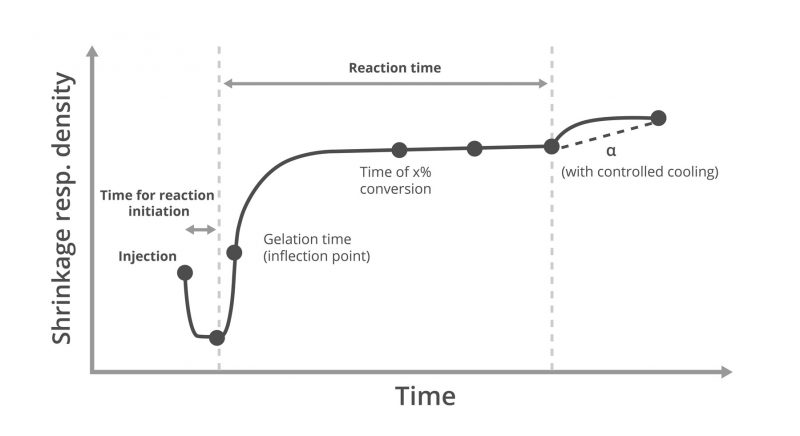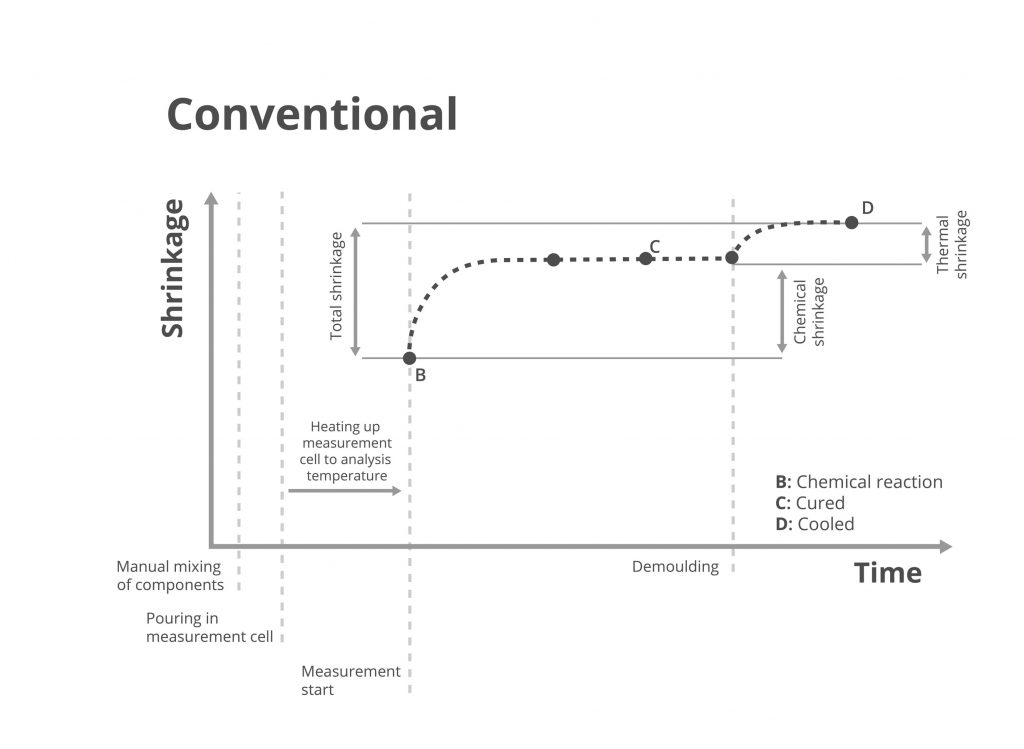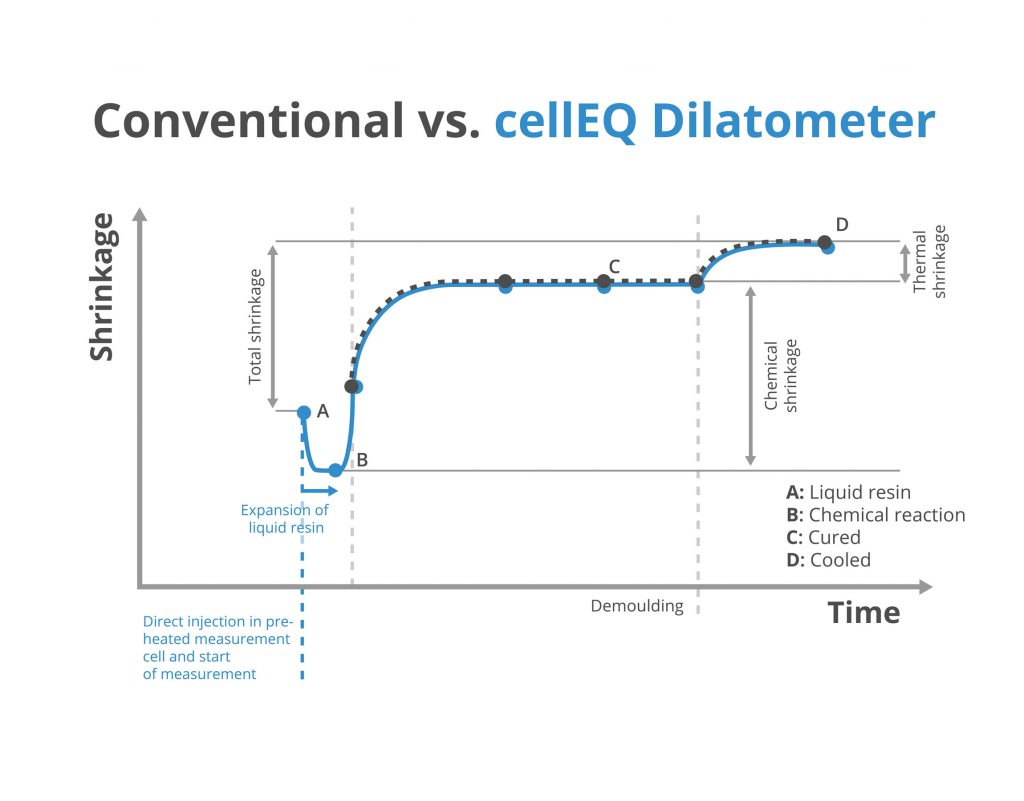Dilatometry has been used for decades to measure the change in the specific volume of various materials under different influences. In the field of reactive materials, dilatometry has so far been used primarily to determine shrinkage and thermal expansion behaviour.
The cellEQ® dilatometer ![]() combines material analysis with an automation and the exact influences of a manufacturing process for the first time. Thus, materials can be examined under the conditions to which they are exposed during their processing and the results are directly transferable. With the integrated mixing and dosing technology, even extremely fast reacting materials can be reproducibly analysed in the isothermally preheated measuring cell.
combines material analysis with an automation and the exact influences of a manufacturing process for the first time. Thus, materials can be examined under the conditions to which they are exposed during their processing and the results are directly transferable. With the integrated mixing and dosing technology, even extremely fast reacting materials can be reproducibly analysed in the isothermally preheated measuring cell.
Technical details and setup
The cellEQ® dilatometers follow a design-to-cost approach. This means you get exactly the specifications (dosing, pressures, temperatures) you need – no more and no less. This way you save money for features that you would not use in your analyses.
Analysis Range
Analysis pressure
Analysis pressure: 0 – 200 bar
Temperature
Temperature ramps and isothermal analysis: Room temperature – 200 °C (upgradeable to 350 °C)
Materials
One- or multicomponent reactive plastics (e.g. EP, PU, UP, VE, SMC, etc.)
Mixing and Dosing
Automated mixing and dosing in high- and low-pressure technology possible
Results of the cellEQ®-Dilatometer
CellEQ® dilatometers enable you to do much more than the shrinkage analysis of your material system. Additionally, various reaction kinetics and thermal characteristic values can be determined from the density change during the reaction.
All parameters can be determined and compared under the influence of different isothermal mould temperatures and materials, different defined pressures, various fillers or auxiliary materials such as release agents or catalysts, mixing and dosing technology and many other process parameters. In this way, the optimal combination of material system and process properties can be found for further material or process development.
Shrinkage analysis

Discrete shrinkage data or complete shrinkage curve as results.

Differentiation between chemical and thermal shrinkage. Meaning to know, what happens with the material during the reaction in the mould and what happens after demoulding.
Time an process dependent reaction kinetics

With the density change of reactive materials during curing, characteristic values can be qualitatively and quantitatively determined. They can also be compared using different process parameters in the analysis. Possible values include:
- the time to start the chemical reaction after dosing into the measuring cell – Initiation
- the gelation time as the time of turnover between liquid and solid
- the time-dependent reaction rate or the time until a previously defined shrinkage is reached
- the complete reaction time
- depending on resolution and previous calibration, the degree of curing at demoulding
- the coefficient of thermal expansion
- as well as additional analysis-specific characteristic values that can be individually defined for the comparison of materials under different process parameters.
Advantages of cellEQ®-Dilatometer
The cellEQ® dilatometers are newest state of research and development. All devices are precisely calibrated during development and production before commissioning and thus for the first time enable the determination of realistic material data, as they are also available during processing. The plastic processing specific focus of the analysis equipment results in a whole series of advantages, which are briefly summarized here. Of course, it is not only each point individually, but above all the combination of all advantages that makes cellEQ® equipment stand out.
No long preparation times
In closed manufacturing processes, multi-component reactive materials are injected directly into an isothermally heated mould after mixing. This process is completely mapped with cellEQ®-dilatometers. By injecting into the temperature-controlled measuring cell and directly starting the measurement, even highly reactive and extremely fast curing materials can be entirely analysed. This is not possible with manual mixing and subsequent introduction into a measuring chamber, which is then heated to analysis temperature. The faster the system reacts, the more data is lost, and the result no longer corresponds to reality in production, even if the measurement is carried out according to the standard.


Mixing and dosing without manual preparation effort
The integrated mixing and dosing technology makes manual preparation (conditioning and mixing of very small quantities) obsolete in the field of multi-component resin systems. This avoids operator-specific errors. Furthermore, the materials experience the same mixing techniques and associated temperatures / energies (e.g. high-pressure mixing) as in the later production process, which affects the chemical reaction. Thus, transferable statements can be made.
Modularity for your process and material
In the field of reactive plastics, there is a wide range of processes and applications and thus a wide variety of possibilities for processing materials.
So, if you don’t need a mixing technique or a direct dosing unit because you process prepregs or moulding compounds such as SMC, but still want to analyse your materials under realistic conditions? No problem – our equipment is modular in design so that we can leave out or add individual system components – just as you need them and as you know them from your processes. The heart of the equipment, the measuring cell, remains mainly the same. Here, too, you can choose between different degrees of complexity, whereby, for example, the integration of additional sensors is possible. Simply contact us with your requirements.
Automation and closed systems
You no longer have to deal with open hazardous chemical substances or follow complex analysis sequences. Use your experience from existing manufacturing processes or material development to operate the equipment – no special training required. The devices are all controlled by a central unit and the data is directly generated.
Get to know more about our product
